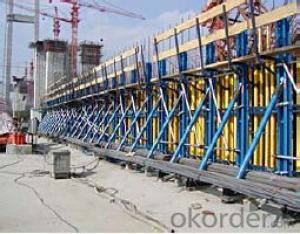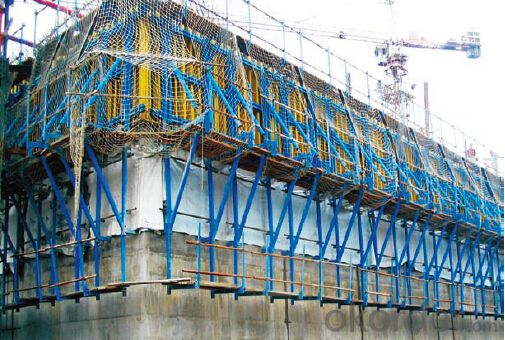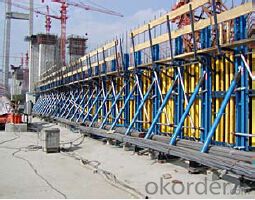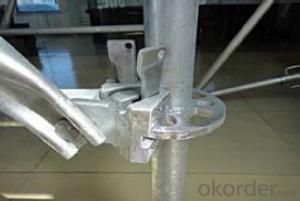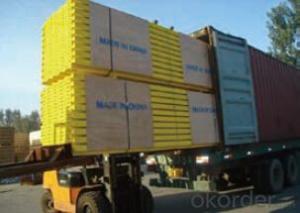Single Side Climbing Bracket for Formwork and Scaffolding system
- Loading Port:
- Tianjin
- Payment Terms:
- TT OR LC
- Min Order Qty:
- 50 m²
- Supply Capability:
- 1000 m²/month
OKorder Service Pledge
OKorder Financial Service
You Might Also Like
Single-side Climbing Bracket SCB180:
With CNBM SCB 180 climbing systems, the loads from the fresh concrete pressure are
transferred through the brackets by means of V-strongbacks and compression braces into the
scaffold anchors.
Typical applications for the SCB 180 are dams, locks, cooling towers, pier heads, tunnels, and
bank vaults.
The formwork is simply tilted backwards when striking takes place. The 1.80 m wide bracket
requires only a minimum of space.
Characteristics:
◆ Economical and safe anchoring
The M30/D20 climbing cones have been designed especially for single-sided concreting using
SCB180 in dam construction, and to allow the transfer of high tensile and shear forces into the still
fresh, unreinforced concrete. Without wall-through tie-rods, finished concrete is perfect.
◆ Stable and cost-effective for high loads
generous bracket spacings allow large-area formwork units with optimal utilization of the bearing
capacity. This leads to extremely economical solutions.
◆ Simple and flexible planning
With SCB180 single-sided climbing formwork, circular structures can also be concreted without
undergoing any large planning process. Even use on inclined walls is feasible without any special
measures because additional concrete loads or lifting forces can be safely transferred into the
structure.
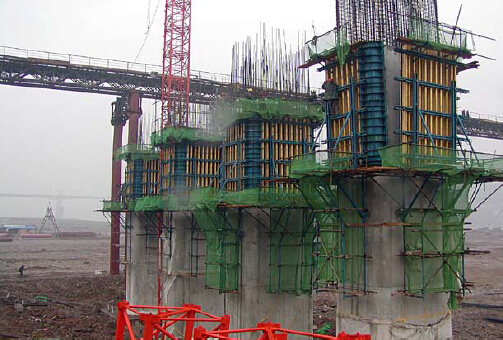
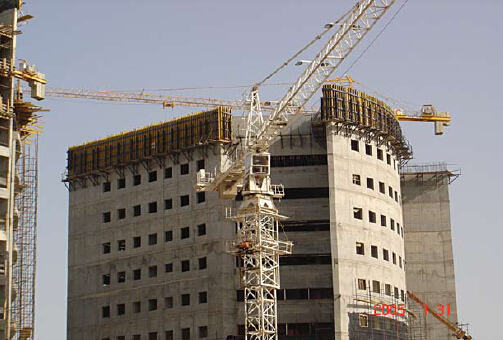
- Q: Are there any specific considerations for using steel formwork in earthquake-prone areas?
- Yes, there are specific considerations for using steel formwork in earthquake-prone areas. Steel formwork is known for its strength and durability, which is why it is often preferred in seismic regions. However, there are several factors that need to be taken into account when using steel formwork in earthquake-prone areas: 1. Flexibility: Steel formwork should be designed to have the necessary flexibility to withstand seismic forces. It should be able to absorb and dissipate the energy generated during an earthquake, reducing the risk of structural damage. 2. Connection details: The connection details between the steel formwork components should be carefully designed and engineered to ensure proper load transfer and resistance to seismic forces. Special attention should be given to the joints and connections to prevent failure or collapse during an earthquake. 3. Reinforcement: Additional reinforcement might be required to enhance the strength and stiffness of the steel formwork system. This reinforcement can be in the form of additional steel bars, cross bracing, or diagonal struts to provide increased resistance against lateral forces. 4. Anchorage: Proper anchorage of the steel formwork to the supporting structure is crucial in earthquake-prone areas. The formwork should be securely anchored to the foundation or the structural elements to prevent displacement or movement during an earthquake. 5. Inspection and maintenance: Regular inspection and maintenance of the steel formwork system are essential in earthquake-prone areas. Any damage or wear should be identified and repaired promptly to ensure the integrity and stability of the formwork system. 6. Compliance with building codes: It is important to ensure that the steel formwork system complies with the local building codes and regulations for seismic design. These codes provide guidelines and requirements for the design, installation, and use of formwork in earthquake-prone areas. By considering these specific factors, using steel formwork in earthquake-prone areas can provide enhanced structural resilience and contribute to the overall safety and durability of the construction project.
- Q: Can steel formwork be used in cold weather conditions?
- Yes, steel formwork can be used in cold weather conditions. Steel is a durable and strong material that can withstand extreme temperatures. However, it is important to consider the potential effects of cold weather on the construction process and the performance of the formwork. In cold weather, the most significant concern is the possibility of freezing temperatures affecting the setting and curing of the concrete. This can cause delays in the construction schedule and affect the quality of the concrete. To address this issue, several measures can be taken when using steel formwork in cold weather conditions. Firstly, it is important to ensure that the formwork is properly insulated to prevent heat loss and maintain the required temperature for the concrete. This can be achieved by using insulating materials such as polystyrene or foam boards around the formwork. Secondly, heating devices such as electric blankets or heat lamps can be used to maintain the desired temperature during the curing process. These devices should be placed strategically to provide uniform heat distribution without damaging the steel formwork. Additionally, it is crucial to plan the construction schedule carefully, taking into account the weather forecast and avoiding pouring concrete during extremely cold periods. Cold weather concreting techniques, such as using accelerators or special admixtures, can also help to increase the rate of concrete setting and prevent freezing. Overall, while steel formwork can be used in cold weather conditions, proper precautions must be taken to ensure the successful completion of the construction project. Adequate insulation, heating devices, and careful scheduling are essential to mitigate the potential challenges posed by cold weather on the performance of the formwork and the quality of the concrete.
- Q: PVC building template introduction
- PVC building template is also called wood plastic formwork, plastic formwork, plastic formwork.PVC building template is an energy-saving and environment-friendly products, after the wooden template, composite steel formwork, bamboo plywood, all steel template and a new type of product. Can completely replace the steel formwork, formwork, timber, traditional energy saving and environmental protection, low cost amortization.
- Q: How does steel formwork handle concrete curing compounds and sealers?
- Steel formwork is highly resistant to concrete curing compounds and sealers. Due to its non-porous surface, steel formwork prevents the penetration of these chemicals, ensuring that they do not interfere with the curing process or affect the quality of the concrete. Additionally, steel formwork is easy to clean and maintain, allowing for efficient removal of any residual compounds or sealers that may come into contact with it during construction.
- Q: How does steel formwork affect the overall energy efficiency of the structure?
- The overall energy efficiency of a structure can be significantly influenced by steel formwork. One of the main advantages of utilizing steel formwork is its capacity to deliver a high degree of thermal insulation. Steel possesses a low thermal conductivity, which means it does not easily transfer heat. This characteristic aids in minimizing heat loss or gain through the walls, floors, and ceilings of the structure. The use of steel formwork allows for improved sealing of the building envelope, which reduces air infiltration and enhances the overall airtightness of the structure. This prevents undesired air leakage, which can result in energy loss and decreased energy efficiency. Steel formwork also enables better control of moisture and humidity levels, which is crucial for maintaining a comfortable indoor environment and preventing mold or moisture-related problems. Moreover, steel formwork offers a durable and long-lasting construction solution. It can withstand extreme weather conditions, seismic activities, and other external forces, guaranteeing the structural integrity of the building for many years. This durability reduces the need for frequent repairs or replacements, leading to energy and resource savings in the long run. Additionally, steel formwork is a sustainable choice as it is frequently made from recycled materials and can be recycled at the end of its lifespan. The utilization of recycled steel diminishes the carbon footprint associated with construction and aids in the conservation of natural resources. The recyclability of steel formwork also means that it can be repurposed or reused in future projects, further reducing waste and environmental impact. In conclusion, steel formwork positively impacts the overall energy efficiency of a structure through its excellent thermal insulation, enhanced airtightness, moisture control, durability, and sustainability. By selecting steel formwork, builders can create energy-efficient buildings that are environmentally friendly and cost-effective in the long term.
- Q: How does steel formwork affect the overall construction site safety measures?
- Steel formwork can significantly enhance the overall safety measures on a construction site. Its sturdy and durable nature provides a stable and secure platform for workers to carry out their tasks, reducing the risk of accidents or structural failures. Steel formwork also offers better protection against potential hazards such as falls, collapses, or material spills, ensuring the safety of workers and minimizing the chances of injury. Additionally, its precision and accuracy in shaping concrete structures contribute to the overall structural integrity, further enhancing the safety of the construction site.
- Q: Can steel formwork be used for both single-story and multi-story structures?
- Yes, steel formwork can be used for both single-story and multi-story structures. Steel formwork is highly versatile and can be easily adjusted and customized to meet the specific requirements of different types of structures. It provides excellent strength and durability, allowing it to handle the load-bearing requirements of multi-story structures with ease. Additionally, steel formwork offers a smooth and high-quality finish, which is essential for both single-story and multi-story structures. It also allows for easy assembly and disassembly, making it a cost-effective and efficient option for construction projects of varying scales. Overall, steel formwork is a suitable choice for both single-story and multi-story structures due to its versatility, strength, durability, and ease of use.
- Q: How does steel formwork handle concrete curing additives?
- Steel formwork is a popular choice for concrete construction due to its durability and strength. When it comes to handling concrete curing additives, steel formwork is highly compatible and can effectively accommodate the use of such additives. Concrete curing additives, such as accelerators or retarders, are used to modify the setting and hardening time of concrete. These additives are typically added to the concrete mixture during the mixing process or applied to the surface of the formwork before pouring the concrete. Steel formwork is not adversely affected by the presence of curing additives in the concrete. It is resistant to chemical reactions and can withstand the potentially corrosive nature of certain additives. This ensures that the steel formwork remains structurally sound and maintains its integrity throughout the concrete curing process. Furthermore, steel formwork offers a smooth and non-porous surface, which allows for easy application and penetration of curing additives. This facilitates the even distribution of additives across the concrete surface, promoting consistent curing and optimal strength development. Moreover, steel formwork is reusable, which means that it can be used for multiple concrete pours. This reusability factor is particularly advantageous when working with concrete curing additives, as the formwork can be easily cleaned after each use, ensuring that no residue or build-up of additives remains on the surface. This helps to prevent any potential interference with subsequent concrete pours or compromising the quality of the cured concrete. In summary, steel formwork is well-suited for handling concrete curing additives. Its chemical resistance, smooth surface, and reusability make it an ideal choice for accommodating the use of curing additives, ensuring efficient and effective concrete curing.
- Q: Can steel formwork be used in high-rise construction projects?
- Indeed, high-rise construction projects can benefit from the utilization of steel formwork. With its versatility and durability, steel formwork proves to be an excellent choice for constructing concrete structures, especially in the realm of high-rise buildings. This option boasts various advantages, such as its exceptional strength, remarkable dimensional stability, and its ability to endure heavy loads and pressure. Moreover, steel formwork guarantees a smooth finish to the concrete surface and promotes environmental sustainability by allowing for easy reusability. Consequently, this minimizes material wastage and effectively reduces project costs. Furthermore, the adaptability of steel formwork systems enables customization to meet the specific requirements of high-rise construction projects, ultimately ensuring efficient and precise construction processes.
- Q: Can steel formwork be easily transported to different construction sites?
- Steel formwork can be conveniently transported to different construction sites. It is renowned for its robustness and resilience, enabling it to withstand transportation without suffering any notable harm. Moreover, steel formwork can be effortlessly disassembled and reassembled, rendering it highly portable. This characteristic empowers construction companies to reuse the formwork at multiple locations, minimizing the necessity for fresh materials and resulting in cost savings. The adaptability and ease of transportation of steel formwork make it a favored option among contractors for diverse construction endeavors.
Send your message to us
Single Side Climbing Bracket for Formwork and Scaffolding system
- Loading Port:
- Tianjin
- Payment Terms:
- TT OR LC
- Min Order Qty:
- 50 m²
- Supply Capability:
- 1000 m²/month
OKorder Service Pledge
OKorder Financial Service
Similar products
Hot products
Hot Searches

